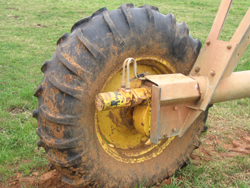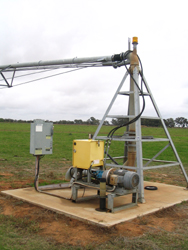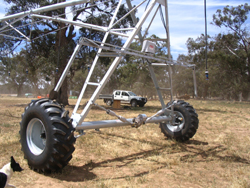4.2.2.7 - Should I choose a hydraulic or an electric drive system ?
The drive motors for pivot (and lateral move) towers are commonly electric, but hydraulic motors can also be used. Hydraulic systems have a diesel or electrically driven hydraulic pump at the centre, driving hydraulic motors on the towers. Electric systems utilise mains electricity or an alternator if diesel powered.
Electric tower motors operate at a constant speed, with the average speed and hence the depth of application controlled by the outer tower which stops for a proportion of each minute. That is, the outside tower travels for a set proportion of each minute, and the inside towers stop and start as required to maintain the alignment of the pivot. The stop-start operation has no significant effect on the uniformity of irrigation, assuming that the throw of the sprinklers is sufficient to provide overlap between step positions.
A hydraulic machine moves at a steady speed set to apply the required depth of application.
Both systems are robust and reliable if they are well designed and properly maintained.
 Hydraulic motor and gearbox |  Hydraulic pump, pipes and oil tank at pivot centre |  Electric drive motor, with drive shafts disconnected from gearboxes for towing (a towable pivot) |


